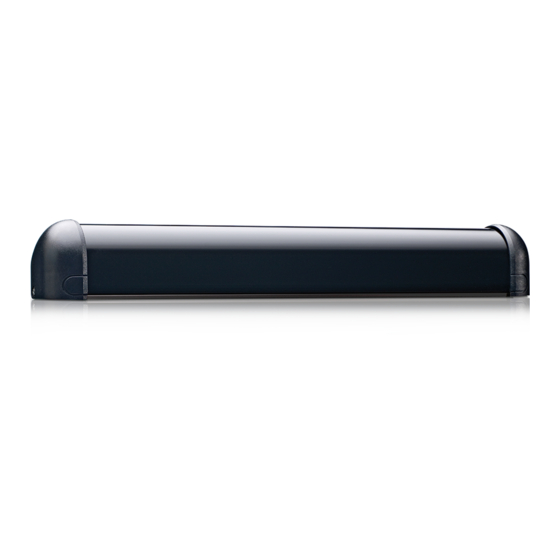Table of Contents
Advertisement
Quick Links
DESCRIPTION
1.
Lens
2.
Master circuit board
3.
Slave circuit board (optional)
4.
Endcaps
5.
Housing
TECHNICAL SPECIFICATIONS
Power supply:
Current consumption:
Inhibit input:
Monitoring request input:
Output interface; relay:
Detection range:
Distance adjustment:
Max. mounting height:
Detection time:
Detection signal duration:
Output hold time:
Operating temperature range:
PCB dimensions:
Connector to door controller:
Master-to-slave connection:
Max. number of slaves:
Functions selection:
Norm conformity:
NOTES:
1. UL10 fire rating applies only to SuperScan-T sensors with housings less than or equal to 46
not UL10 fire-rated.
75.5911.03 SUPERSCAN-T 20180719
75.5911.03 SUPERSCAN-T 20180719
4
12 – 24 VAC/VDC ±10%
Master:
on = 60 mA max.
off = 30 mA max.
12 – 24 VAC/VDC ±10% (inhibited when voltage is applied)
12 – 35 VDC required (polarity-sensitive)
min. pulse width duration = 50 ms
relay – max. contact rating: 1A @ 30v (resistive)
0 – 8'
2 – 8' (rotating cam w/linear adjustment)
8'
< 50 ms
Infinite Presence Detection
Potentiometer range: 0.1 – 4.5 seconds
-30 – 140 °F
Master:
10.91" x 1.5"
8-position screw terminal on Master PCB
flat-ribbon cable w/connectors and key lock
8
Detection mode: NO or NC
Normal mode or Background Analysis mode
UL 10B/C (90 minutes)
UL 10B file number: GVUX.R39071; UL10C file number: GVUX7.R39071
SUPERSCAN-T
Door-Mounted, Presence Sensor for
Automatic, Pedestrian Doors
SuperScan-T sensors are intended to be used with pedestrian, swing door systems.
3
Slave:
on = 40 mA max.
off = 30 mA max.
Slave:
8.75" x 1.5"
1
1
2
5
⁄
". Housings greater than 46
1
2
4
⁄
" are
1
2
Page 1 of 8
Page 1 of 8
Advertisement
Table of Contents

Summary of Contents for BEA SUPERSCAN-T
-
Page 1: Technical Specifications
Norm conformity: UL 10B/C (90 minutes) UL 10B file number: GVUX.R39071; UL10C file number: GVUX7.R39071 NOTES: 1. UL10 fire rating applies only to SuperScan-T sensors with housings less than or equal to 46 ⁄ ”. Housings greater than 46 ⁄... -
Page 2: Installation
SLAVE (red) (red) Presence detection Presence detection (green) Sensor powered, non-detection For other LED indications based on relay configuration, see page 5 - J2: Relay Mode. Page 2 of 8 Page 2 of 8 75.5911.03 SUPERSCAN-T 20180719 75.5911.03 SUPERSCAN-T 20180719... -
Page 3: Mechanical Installation
Align the housing with the pilot holes and secure to the door with the 2 provided screws. Drill the marked holes (ensuring proper hole size). 75.5911.03 SUPERSCAN-T 20180719 75.5911.03 SUPERSCAN-T 20180719 Page 3 of 8 Page 3 of 8... -
Page 4: Jumper Settings
BACKGROUND ANALYSIS ON BACKGROUND ANALYSIS OFF viewed from the "front" side Jumper settings for this function must be set on both the Master and the Slave boards. Page 4 of 8 Page 4 of 8 75.5911.03 SUPERSCAN-T 20180719 75.5911.03 SUPERSCAN-T 20180719... - Page 5 Slave Jumper 4 serves to indicate the end of the line of modules. MASTER ONLY MASTER & SLAVE(S) Master Jumper Slave Jumper 75.5911.03 SUPERSCAN-T 20180719 75.5911.03 SUPERSCAN-T 20180719 Page 5 of 8 Page 5 of 8...
- Page 6 Inhibition occurs when 12 – 24 VAC/VDC ±10% is applied between terminal 3 and terminal 2. Normally Open: JP2 factory default will close the relay contact on terminal 4 when the SuperScan-T is energized and not in detection. Loss of power results in a N.O. contact Normally Closed: JP2 factory default will open the relay contact on terminal 5 when the SuperScan- T is energized and not in detection.
- Page 7 - if zone Y is too high, turn the adjustment knob clockwise to increase the detection distance and decrease zone Y - if zone Y is too low, turn the adjustment knob counterclockwise to decrease the detection distance and increase zone Y 75.5911.03 SUPERSCAN-T 20180719 75.5911.03 SUPERSCAN-T 20180719 Page 7 of 8 Page 7 of 8...
-
Page 8: Finishing Touches
BEA strongly recommends that installation and service technicians be AAADM-certifi ed for pedestrian doors, IDA-certifi ed for doors/gates, and factory- trained for the type of door/gate system.












